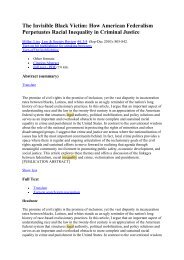Ski – resort and regional development: profile of visitors ... - E-Journal
Ski – resort and regional development: profile of visitors ... - E-Journal
Ski – resort and regional development: profile of visitors ... - E-Journal
Create successful ePaper yourself
Turn your PDF publications into a flip-book with our unique Google optimized e-Paper software.
The carrying capacity <strong>of</strong> mountainous tourist areas: the case <strong>of</strong> plastira’s lake<br />
manufacture). (d) In the last decades, important socio-economic transformations <strong>and</strong><br />
<strong>development</strong>s have taken place that basically result from demographic <strong>development</strong>, the<br />
tendency to residence <strong>and</strong> employment, the reformations <strong>and</strong> changes <strong>of</strong> the rural sector, the<br />
increasing needs for the protection <strong>of</strong> the environment, the new possibilities that the area<br />
<strong>of</strong>fers for alternative forms <strong>of</strong> tourism <strong>and</strong> recreation, but also from the more general<br />
<strong>development</strong>al process (GTO, 2003).<br />
All the actions that were developed form a complete program <strong>of</strong> rural innovation that does<br />
not cover <strong>of</strong> course all the needs <strong>of</strong> the rural industry, but is a multi-sector intervention whose<br />
experience can support the local society <strong>and</strong> contribute substantially to new <strong>development</strong>al<br />
prospects, that promote the area, improve the quality <strong>of</strong> life, create new knowledge <strong>and</strong><br />
techniques, new products <strong>and</strong> services.<br />
CONCLUSION<br />
To conclude what has been discussed in the paper, it is clear that tourism is having an impact<br />
on the environment <strong>and</strong> changing the character <strong>and</strong> structures <strong>of</strong> the mountainous areas.<br />
Negative externalities on the environment also decrease the environmental quality. In other<br />
words, tourism planning is typically a short period policy but its aim must be a long period<br />
policy because tourism is a rapidly developing industry <strong>and</strong> is having negative impacts which<br />
threaten to destroy the historic <strong>and</strong> architectural heritage (Gunce, 2003).<br />
The mountainous tourism is a basic <strong>development</strong>al factor for the less favoured areas <strong>of</strong> Greece.<br />
We can not argue its contribution to the economic <strong>development</strong>, despite any criticism it has<br />
faced because <strong>of</strong> its negative impact. The version <strong>of</strong> the sustainable mountainous tourism<br />
<strong>development</strong> should be placed theoretically between the maximum <strong>and</strong> the minimum <strong>of</strong> the<br />
carrying capacity <strong>of</strong> each area.<br />
In this article firstly we investigate the tourism carrying capacity <strong>of</strong> a mountainous area, which<br />
presented a big increase in the number <strong>of</strong> tourists in the last decade. The results showed that<br />
potential for <strong>development</strong> without any environmental problems still exist.<br />
Under a general regard, we appreciate that the mountainous tourism in Greece still has not<br />
attained such sizes, in order to decide between a scenario <strong>of</strong> intensive tourism or in a moderate<br />
one <strong>of</strong> alternative tourism. A scenario <strong>of</strong> mountainous sustainable <strong>development</strong> can <strong>of</strong>fer<br />
enough choices for the tourism <strong>development</strong> <strong>and</strong> the carrying capacity <strong>of</strong> the area.<br />
We estimate that the scenario <strong>of</strong> a "mild tourism" is more suitable for the Plastira's Lake area.<br />
Despite the fact that the area has reached the limits <strong>of</strong> its capacity, efforts from central <strong>and</strong><br />
local institutions to the sustainable <strong>development</strong> <strong>of</strong> area promoting s<strong>of</strong>t forms <strong>of</strong> tourism<br />
<strong>development</strong> must be undertaken. This <strong>development</strong> must be harmonised with the principles<br />
<strong>of</strong> viable <strong>development</strong>. Moreover, must contain elements <strong>of</strong> "nature tourism" or "sustainable<br />
Tourism Today - Fall 2007 - Full Paper<br />
121














